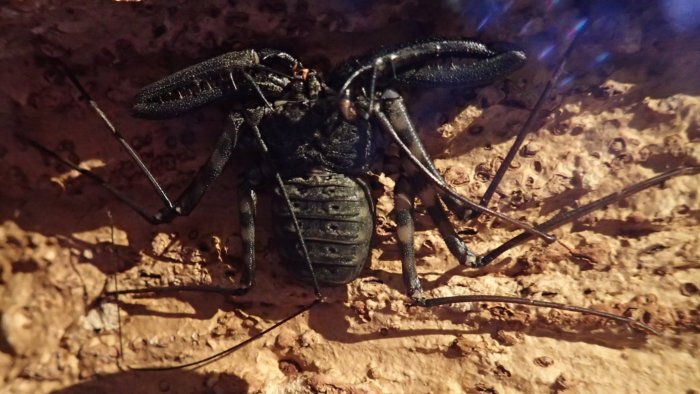Grand Traverse Butterfly House and Insect Zoo
We took a trip to southern Michigan and part of Ohio from June 14 to June 22, 2016, and on our way back we stopped to visit the Grand Traverse Butterfly House and Insect Zoo[1], which is just outside of Traverse City
The butterfly house portion is a simulated tropical rainforest, with a nice waterfall and flowers everywhere.
In addition to the flowers for nectar, there are also feeding stations where the butterflies can get fruit juices.
There were lots of species of butterflies around, as far as I could see they were all tropical species.
The way they get their butterflies, is to order them from dealers as chrysalises. They told me that their license from the State of Michigan doesn’t allow them to actually rear butterflies themselves, or to keep anything other than tropical species that can’t survive in our climate. I guess there are fears that escaped temperate-zone butterflies could get established in the area and could turn out to be invasive pests[2]. The chrysalises are hung from bars behind a window so that visitors can see them.
And, there are constantly butterflies emerging. There is a lot of turnover, with an individual butterfly living about a month or so, so they get new chrysalises on pretty much a weekly basis.
The chrysalises are identified by species, and the names I was able to pick out from my pictures are:
Cethosia cyane
Doleschallia bisaltide
Papilio ophidicephalus
Charaxes castor
Morpho polyphemus
Papilio demodocus
Pachilopta kotzebuea
Papilio constantinus
Pachilopta kotzebuea
Siproeta epaphus
Morpho peleides
Charaxes varanes
Papilio nireus
Troides rhadamantus plateni
Cethosia biblis
Parthenos slyvia philippinensis
Catonephele numilia
Chilasa clytia
If anyone wants to treat this as a puzzle, try matching the names to my pictures!
Sometimes, one doesn’t inflate its wings properly and ends up unable to fly. Rosie was allowed to have one such butterfly sit on her hands.
Since there are plenty of feeding stations, butteflies in this condition will still do OK as long as they are transferred to where there is food.
From time to time, butterflies would land on people, although mostly they would take off again before I could get a picture. Except for this big one that roosted on the seat of Sandy’s pants for a couple of minutes.
In addition to the butterflies, there were a few moths, like this Atlas Moth that had close to an 8-inch wingspan (basically, each wing is about the size of a person’s hand)
And then, of course, there was the insect zoo portion, with creatures that you don’t necessarily want to get up-close and personal with, either because they could sting or bite, or because they don’t react well to being touched.
(I only got a few pictures in the zoo portion, because a lot of them like dim light and it really wasn’t bright enough for photography).
It wasn’t entirely insects, they also had an aquarium of axolotls. These are captive-bred, and in fact the white one is a laboratory-bred strain that they said had been genetically engineered to be fluorescent in ultraviolet light.
Overall, it was a great place to visit, and if any of you happen to be in the vicinity of Traverse City, I highly recommend stopping by!
———————
[1] I hadn’t even known about this place until about two weeks before our trip, when I saw a mention of it in the newsletter of the Michigan Entomological Society. And, since it turned out that neither Sandy or I had ever been up to the Traverse City area, we decided that on our way back north it it would be interesting to stop off there. Once in the area, we ended up camping for a day at the state park, and riding around town on tandem bikes that we rented from the bike shop. I highly recommend the Grand Traverse Pie Company for lunch. They have pie. Many kinds of pie. Traverse City is the place to get tart cherries, and pies made with them (although they also make non-cherry pies that are equally excellent).
[2] Now I wonder about whether there are restrictions on rearing insects that got here on their own, though. There are at least a few dozen species of rather showy butterflies that I can catch locally, I wonder if it would be legal to have a butterfly house/rearing facility that only reared local species? Would that even need a permit? It wouldn’t be bringing anything across state lines. Maybe I should look into it for something to do in my old age . . .
Comments are closed.
























I think a butterfly house of local butterflies and local plants would be much more interesting. If they aren’t allowed to raise local butterflies, if they used local plants for nectar people would learn what to plant to attract butterflies. Didn’t see any host plants in your pics.
Libertarian curmudgeon says: Of course you’d need a permit. That goldarned gubmint wants to regulate and tax and control everything! Why, it’s getting to be that you can’t hardly even look at a Polygonia faunus without permission from some boor-o-crat!
In all seriousness, I love exhibits like this where the environment is so large that the animals don’t know they’re enclosed. I’ve always been a big fan of South American tetras and wished I could build a big swimming pool for them so I could watch what they do in the wild.
Here in San Diego, the Wild Animal Park used to have an annual Butterfly House exhibit where they did the same thing. Lovely!
Thanks for sharing your photos.
By the way, I’ve seen aquariums so big the fish didn’t know they were in one. What do tetras do in the wild? Not much of anything. They’re not exactly creative geniuses.